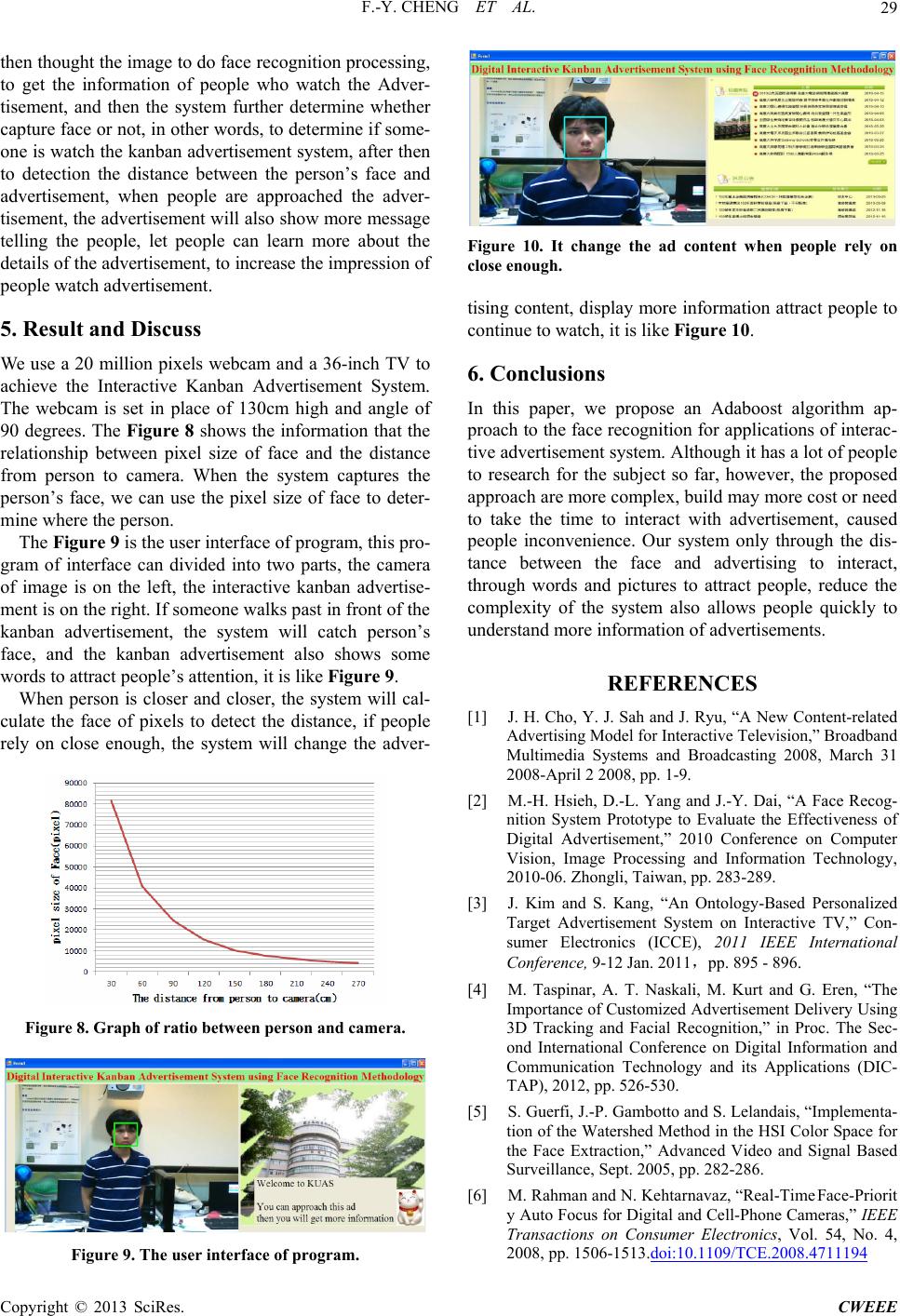
F.-Y. CHENG ET AL. 29
then thought the image to do face recognition processing,
to get the information of people who watch the Adver-
tisement, and then the system further determine whether
capture face or not, in other words, to determine if some-
one is watch the kanban advertisement system, after then
to detection the distance between the person’s face and
advertisement, when people are approached the adver-
tisement, the advertisement will also show more message
telling the people, let people can learn more about the
details of the advertisement, to increase the impression of
people watch advertisement.
5. Result and Discuss
We use a 20 million pixels webcam and a 36-inch TV to
achieve the Interactive Kanban Advertisement System.
The webcam is set in place of 130cm high and angle of
90 degrees. The Figure 8 shows the information that the
relationship between pixel size of face and the distance
from person to camera. When the system captures the
person’s face, we can use the pixel size of face to deter-
mine where the person.
The Figure 9 is the user interface of program, this pro-
gram of interface can divided into two parts, the camera
of image is on the left, the interactive kanban advertise-
ment is on th e righ t. If so meon e walks p ast in fron t of th e
kanban advertisement, the system will catch person’s
face, and the kanban advertisement also shows some
words to attract people’s attention, it is like Figure 9.
When person is closer and closer, the system will cal-
culate the face of pixels to detect the distance, if people
rely on close enough, the system will change the adver-
Figure 8. Graph of ratio between person and camera.
Figure 9. The user interface of program.
Figure 10. It change the ad content when people rely on
close enough.
tising content, display more information attract people to
continue to watch, it is like Figure 10.
6. Conclusions
In this paper, we propose an Adaboost algorithm ap-
proach to the face recognition for applications of interac-
tive advertisement system. Although it has a lot of people
to research for the subject so far, however, the proposed
approach are more complex, build may more cost or need
to take the time to interact with advertisement, caused
people inconvenience. Our system only through the dis-
tance between the face and advertising to interact,
through words and pictures to attract people, reduce the
complexity of the system also allows people quickly to
understand more information of advertisements.
REFERENCES
[1] J. H. Cho, Y. J. Sah and J. Ryu, “A New Content-related
Advertising Model for Interactive Television,” Broadband
Multimedia Systems and Broadcasting 2008, March 31
2008-April 2 2008, pp. 1-9.
[2] M.-H. Hsieh, D.-L. Yang and J.-Y. Dai, “A Face Recog-
nition System Prototype to Evaluate the Effectiveness of
Digital Advertisement,” 2010 Conference on Computer
Vision, Image Processing and Information Technology,
2010-06. Zhongli, Taiwan, pp. 283-289.
[3] J. Kim and S. Kang, “An Ontology-Based Personalized
Target Advertisement System on Interactive TV,” Con-
sumer Electronics (ICCE), 2011 IEEE International
Conference, 9-12 Jan. 2011,pp. 895 - 896.
[4] M. Taspinar, A. T. Naskali, M. Kurt and G. Eren, “The
Importance of Customized Advertisement Delivery Using
3D Tracking and Facial Recognition,” in Proc. The Sec-
ond International Conference on Digital Information and
Communication Technology and its Applications (DIC-
TAP), 2012, pp. 526-530.
[5] S. Guerfi, J.-P. Gambotto and S. Lelandais, “Implementa-
tion of the Watershed Method in the HSI Color Space for
the Face Extraction,” Advanced Video and Signal Based
Surveillance, Sept. 2005, pp. 282-286.
[6] M. Rahman and N. Kehtarnava z, “Real-T imeFace-Priorit
y Auto Focus for Digital and Cell-Phone Cameras,” IEEE
Transactions on Consumer Electronics, Vol. 54, No. 4,
2008, pp. 1506-1513.doi:10.1109/TCE.2008.4711194
Copyright © 2013 SciRes. CWEEE